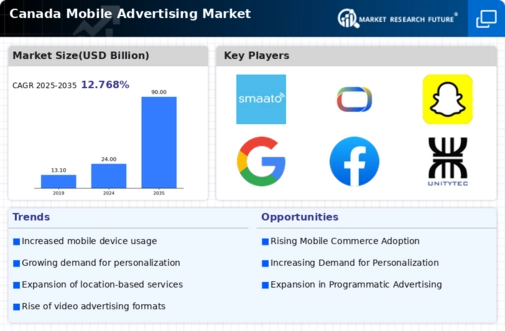Increased Mobile Commerce
The rise of mobile commerce is significantly influencing the mobile advertising market in Canada. In 2025, mobile commerce sales are projected to account for over 30% of total e-commerce sales in the country. This trend suggests that consumers are increasingly using their mobile devices for shopping, which creates a fertile ground for targeted advertising. Advertisers are likely to leverage this trend by integrating mobile ads with seamless shopping experiences, such as in-app purchases and mobile-optimized websites. The potential for higher conversion rates in mobile commerce is compelling, as users are more inclined to respond to ads that lead directly to purchasing opportunities. Consequently, The mobile advertising market is expected to evolve, focusing on strategies that enhance the shopping experience and drive sales.
Expansion of 5G Technology
The rollout of 5G technology is poised to transform the mobile advertising market in Canada. With 5G networks offering significantly faster data speeds and lower latency, advertisers can deliver richer and more interactive ad experiences. As of 2025, it is estimated that over 50% of Canadians will have access to 5G networks, enabling the use of advanced advertising formats such as augmented reality (AR) and virtual reality (VR). This technological advancement may lead to more immersive advertising experiences, allowing brands to engage consumers in novel ways. The potential for enhanced user experiences could drive higher engagement rates, making 5G a critical factor in the evolution of the mobile advertising market. Advertisers are likely to explore innovative strategies that leverage 5G capabilities to capture consumer attention and foster brand loyalty.
Rising Smartphone Penetration
The mobile advertising market in Canada is experiencing a notable surge due to the increasing penetration of smartphones. As of 2025, approximately 85% of Canadians own a smartphone, which facilitates access to mobile advertising platforms. This widespread adoption enables advertisers to reach a larger audience effectively. The mobile advertising market is likely to benefit from this trend, as more users engage in mobile applications and websites. Furthermore, the growth of mobile internet usage, which has reached around 90% among smartphone users, indicates a shift in consumer behavior towards mobile-first interactions. This shift presents a significant opportunity for advertisers to tailor their strategies to engage users through mobile devices, thereby enhancing the effectiveness of their campaigns in the mobile advertising market.
Growing Demand for Video Content
The mobile advertising market in Canada is witnessing a growing demand for video content, which is becoming a dominant format for advertising. As of 2025, video ads are projected to account for nearly 70% of all mobile advertising expenditures. This shift is driven by the increasing consumption of video content on mobile devices, with Canadians spending an average of 2 hours daily watching videos on their smartphones. Advertisers are likely to capitalize on this trend by creating engaging video ads that resonate with mobile users. The effectiveness of video advertising in capturing attention and driving engagement suggests that brands may prioritize video content in their mobile advertising strategies. This evolution in content consumption is reshaping the landscape of the mobile advertising market, pushing advertisers to innovate and adapt to consumer preferences.
Shift Towards Localized Advertising
The mobile advertising market in Canada is increasingly shifting towards localized advertising strategies. As consumers become more inclined to support local businesses, advertisers are recognizing the importance of targeting specific geographic areas. In 2025, it is anticipated that localized ads will account for approximately 40% of mobile advertising spend. This trend indicates a growing preference for personalized and relevant advertising experiences. Advertisers may utilize location-based services and data analytics to tailor their campaigns to local audiences, enhancing the effectiveness of their messaging. The emphasis on localized advertising not only supports community engagement but also allows brands to connect with consumers on a more personal level. This strategic shift is likely to redefine the landscape of the mobile advertising market, as businesses adapt to meet the evolving preferences of Canadian consumers.

















Leave a Comment